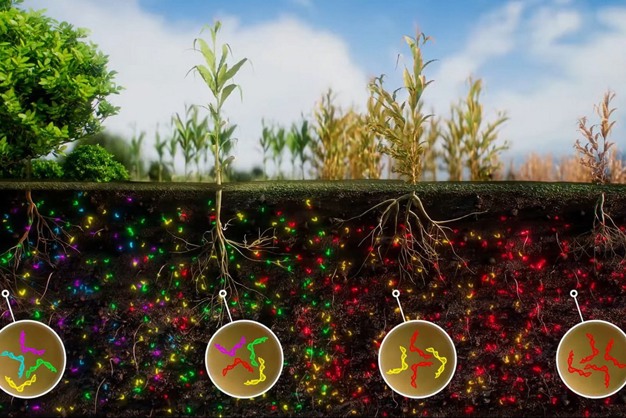Soil fatigue is a common problem in agriculture, especially when the same vegetable species is cultivated repeatedly on the same land. This leads to various agronomic problems, including reduced root development, lower vigor and productivity and increased sensitivity to diseases and environmental stress.
This problem has been known since ancient times. Greek and Roman historic authors such as Theophrastus and Columella described practices such as crop rotation and lying fallow to counter production decline, which for a long time was interpreted as an impoverishment of the nutrients in the soil.
 Representation of soil fatigue according to the accumulation of self-DNA of the plant grown.
Representation of soil fatigue according to the accumulation of self-DNA of the plant grown.
In modern time, synthetic and mineral fertilizers have not solved the issue, revealing the greater complexity of the problem. Already during the 19th century, some scholars started exploring the idea that plants could release toxins into the soil, a theory that became more popular over time. In Italy, research was conducted by professor Franco Zucconi who believed that, in addition to root exudates, crop residues also released self-toxin substances, i.e. toxic for the species they originated from. His research strengthened the hypothesis that soil fatigue had toxigenic origins.
More recently, the concept of self-toxicity has been reinterpreted and analyzed in depth on the basis of the discovery of the inhibitory and species-specific role of extra-cellular DNA. This theory is represented in a recent video that described the cycle of extra-cellular DNA in the ecosystems and its hypothesized ability to determine soil fatigue.
The video was made by the NoSelf research group, made up of various researchers part of Italian and foreign universities who, over the past few years, studied the biological mechanisms and application potential of inhibition due to self-DNA..
Over the years, in addition to studying the issue of soil fatigue, the research group also highlighted how self-DNA inhibition applies not only to plants, but to animals and fungi as well. This additional theory is at the basis of the development of the biological control strategy in agriculture, based on the use of the DNA of unwelcome species whether they are fungi, insects or plants. They believe in fact that the DNA taken from a specific parasite or pathogen could be used as an active principle to inhibit and control exclusively the target organism in a natural and harmless way for other species.
The discover of the inhibitory role of self-DNA could lead to more effective agronomic strategies inspired by biodiversity and the balance of natural ecosystems without undesired effects on man and the environment.
